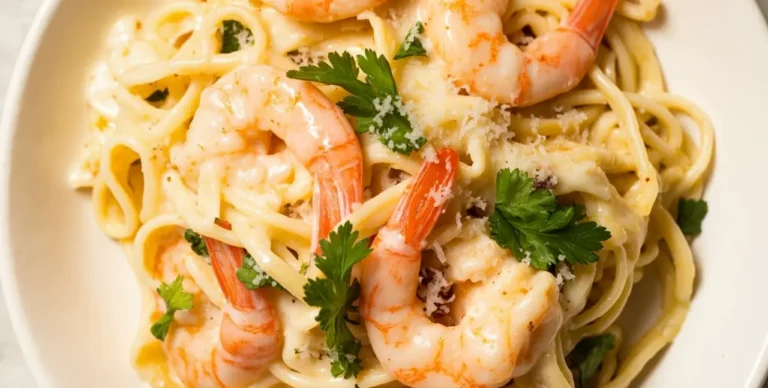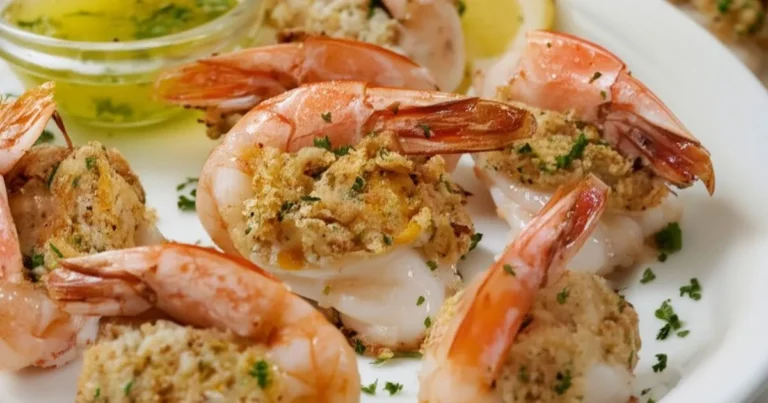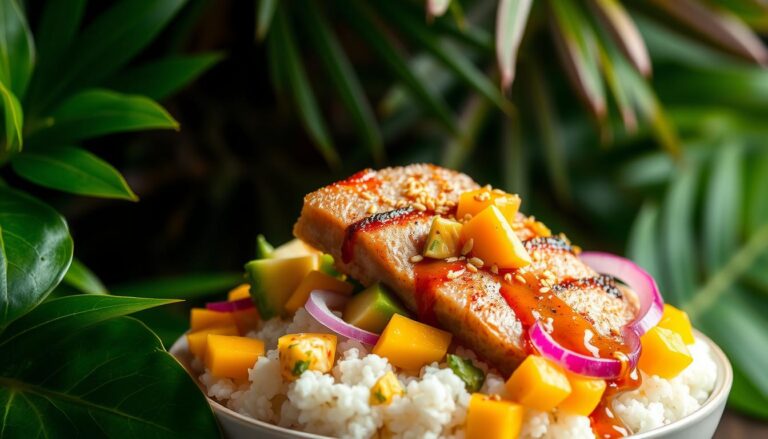best recipes for you
Easy ahi tuna recipe: How to Sear Ahi Tuna Perfectly at Home
Table of Contents
There’s something special about a perfectly seared ahi tuna. Its caramelized crust and buttery-pink center are irresistible. But what if we told you you can make this dish at home without a professional kitchen?
This guide will turn your stove into a culinary stage. It teaches you how to master that coveted sear. Whether you’re new to cooking or have experience, this ahi tuna recipe covers every detail. From choosing the freshest fish to avoiding overcooking, it’s all here.
Imagine serving a seared ahi tuna that rivals your favorite sushi spot. And you can do it all with ingredients from your local market.
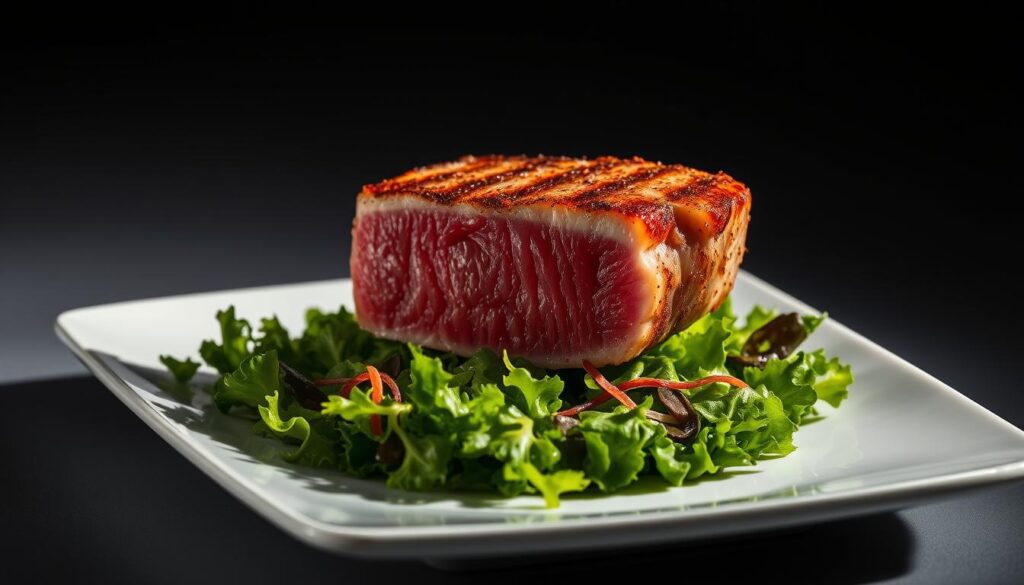
Key Takeaways
- Learn the foolproof steps to achieve a restaurant-quality seared ahi tuna at home.
- Discover how to pick the best cuts of ahi tuna for even cooking and flavor.
- Master the pan-searing technique to balance texture and doneness.
- Understand how simple ingredients elevate this ahi tuna recipe without complexity.
- Get solutions for common mistakes like dry meat or uneven seasoning.
Introduction to Ahi Tuna: The Perfect Protein for Home Chefs
Ahi tuna is a standout in the kitchen for its versatility and bold flavor. Known as yellowfin or bigeye tuna, it has a firm, buttery texture. This makes it perfect for bold spices. Learning how to cook ahi tuna brings elegance and ease to your dishes.
What Makes Ahi Tuna Special
Ahi tuna has a mild, sweet taste and a dense texture. Unlike flaky fish, it stays firm under high heat. Look for steaks with a deep red-pink color for freshness. Each 3-ounce serving packs 25g of protein, making it a nutritional powerhouse.
Why Searing is the Ideal Cooking Method
Searing creates a caramelized crust that seals in juices. This keeps the center tender. Here’s why it’s the best method:
- Retains moisture through rapid cooking
- Develops umami flavors without drying the fish
- Preserves the sought-after rare-to-medium-rare doneness
Steaming or poaching would mute its natural richness. Grilling risks flare-ups. Searing ensures consistency every time.
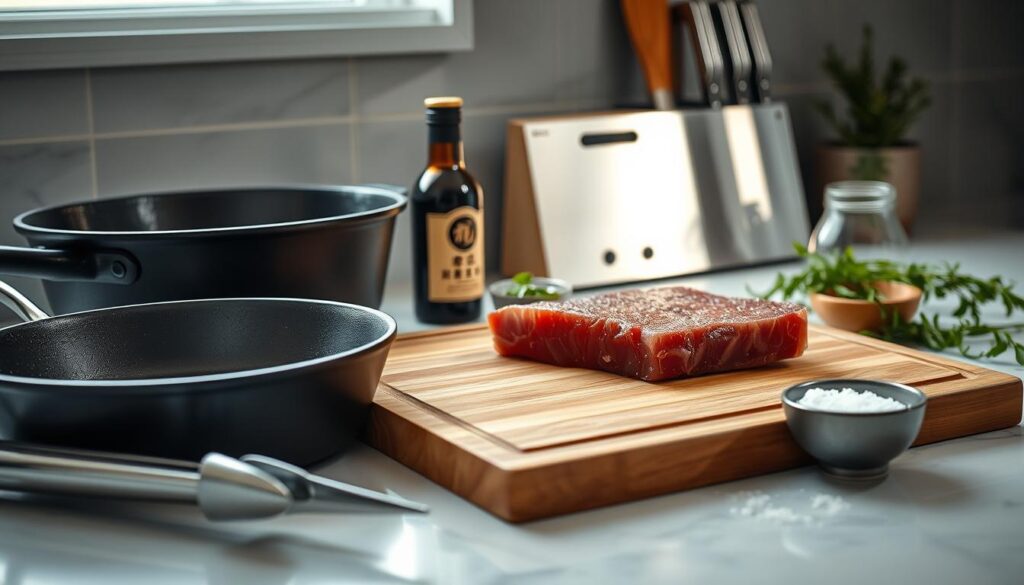
Equipment You’ll Need for This Recipe
Success starts with the right tools. Gather:
- Heavy skillet: Cast iron or stainless steel conducts heat evenly
- Instant-read thermometer: Ensure internal temp reaches 125°F-130°F
- Sharp chef’s knife: For clean cuts against its dense flesh
- Heat-safe tongs: Avoid piercing the steak while flipping
These essentials help you master the technique of how to cook ahi tuna like a pro.
Selecting the Best Ahi Tuna for Your Recipe
Choosing the right ahi tuna is key to a great easy ahi tuna recipe. Know what to look for at the store or market.
Fresh vs. Frozen Ahi Tuna
Frozen ahi tuna can be just as good as fresh. Flash-freezing keeps flavor and safety in. Here’s how to pick:
- Fresh: Choose vacuum-sealed packs labeled “sashimi-grade” to avoid air. Make sure the date is within 24-48 hours.
- Frozen: Look for solid ice crystals (no slush) and clear labels with catch dates. Thaw it in the fridge overnight before cooking.
Color and Texture Indicators of Quality
Quality ahi tuna has bright color and firmness. Check these signs:
- Color: It should be bright red or pink, not brown or gray. Dull colors mean it’s old.
- Texture: It should spring back when pressed gently. Soft or mushy spots mean it’s not fresh.
- Smell: It should smell clean and oceanic. Avoid fishy or ammonia smells.
Sustainable Sourcing Guidelines
Look for MSC-certified or Pacific Bluefin labels for sustainable tuna. Buy from trusted places like Sea to Table or Wild Catch Market. Aim for 4-6 oz per serving to avoid too much. Supporting sustainable fishing helps the environment and future meals.
Essential Ingredients for a Delicious Ahi Tuna Recipe
Creating a delicious ahi tuna recipe begins with top-notch ingredients. The key is fresh ahi tuna steaks, 1-1.5 inches thick. This ensures they sear well and stay tender inside. Here’s what you’ll need:
- Ahi tuna steaks: Opt for sushi-grade for the best taste and texture.
- High smoke point oil: Avocado or grapeseed oil works well at high heat.
- Kosher or sea salt: These salts have bigger crystals that penetrate better than table salt.
- Black pepper: Freshly ground black pepper adds a rich flavor without overpowering the fish.
- Optional flavor boosters: Try sesame seeds, garlic powder, or ginger for extra taste.
Pair your tuna with a simple soy-ginger sauce or a citrus marinade. Drizzle sesame oil over the tuna for more umami. If you have nut allergies, use crushed peanuts instead of sesame seeds. Remember, adjust the salt if you’re using soy sauce.
Pro tip: Add fresh lemon or lime zest to brighten the dish. It enhances the tuna’s flavor without overpowering it. Quality ingredients are crucial in this delicious ahi tuna recipe. Choose well and let the flavors stand out.
Preparing Your Ahi Tuna Before Cooking
Getting good at making ahi tuna starts with careful prep. These steps help you get the best texture and taste. Follow them to make your dish as good as a restaurant’s.
Proper Thawing Techniques
If your tuna is frozen, thaw it safely with these methods:
- Thaw it in the fridge overnight for the best quality.
- For quicker thawing, seal it in a waterproof bag and soak in cold water. Change the water every 30 minutes.
- After thawing, pat it dry with paper towels to remove excess moisture before cooking.
Trimming and Portioning
Check the tuna for dark spots or sinew and remove them. Cut it into 4-6 oz portions for even cooking. Slice it against the grain after cooking for tenderness. Make sure all pieces are the same thickness to prevent uneven searing.
Creating the Perfect Seasoning Blend
Begin with a mix of salt, black pepper, and toasted sesame seeds. Try these seasoning blends:
- Asian-inspired: soy sauce, minced ginger, garlic powder.
- Mediterranean: lemon zest, oregano, cracked pepper.
- Cajun: smoked paprika, cayenne, parsley.
Lightly coat the tuna with oil first. Then, gently press the spices into the surface. Season just before cooking to keep the flavors fresh.
The Step-by-Step Ahi Tuna Recipe: Searing to Perfection
Learn to make seared ahi tuna with these easy steps. Each step is crucial for a perfect golden crust and a tender center. Follow this guide to make restaurant-quality ahi tuna at home.
Room Temperature Preparation
Let your seasoned tuna sit at room temperature for 20–30 minutes. This helps it cook evenly and keeps the center moist. Pat the tuna dry before cooking.
Pan Selection and Heating
Choose a heavy skillet like cast iron for even heat. Heat it over medium-high for 5–7 minutes. To check if it’s ready, sprinkle water on it—if it sizzles and disappears fast, it’s ready.
Add just enough avocado oil to coat the bottom. Heat until it starts to shimmer but doesn’t smoke.
Timing the Perfect Sear
- Put the tuna in the pan. Cook for 60–90 seconds on each side for rare, 2 minutes per side for medium-rare.
- Flip it only once with tongs. Press gently while cooking for full contact with the pan.
- Check if it’s done: rare should feel soft, medium-rare a bit firm. Avoid overcooking to keep it moist.
Resting for Optimal Flavor
Let the tuna rest for 5 minutes before slicing. This lets the juices spread evenly. Slice against the grain and serve with citrus or a soy-ginger glaze.
If it’s undercooked, reheat it briefly. If it’s overcooked, slice it thin to reduce dryness.
Creative Serving Suggestions for Your Seared Ahi Tuna
Make your delicious ahi tuna recipe even better with these creative ideas. Start with the classic slice: arrange thin pieces on a plate, fanned out to show off their rosy center. The seared edges should shine, while the inside stays soft.
- Asian-inspired bowl: Layer seared tuna over jasmine rice, top with shredded carrots, edamame, and a drizzle of soy-ginger glaze.
- Salad star: Tuck slices into a bed of peppery arugula with avocado, blood orange segments, and a citrus-tahini dressing.
- Taco night: Serve warm tortillas filled with tuna, pickled onions, and a dollop of wasabi mayo.
- Appetizer platter: Arrange tuna with roasted beet slices and a tangy ponzu sauce for dipping.
Pair with sides like sesame-kissed cucumber salad or coconut-infused quinoa to balance flavors. Add garnishes like microgreens, toasted sesame seeds, or a lemon wedge for extra brightness. For smaller portions, cube tuna into a poke bowl with marinated veggies. Always let the tuna’s rich flavor shine—keep accompaniments simple to avoid overpowering its natural sweetness. Whether as a main course or party bite, these options turn your seared tuna into a standout dish.
Health Benefits of Including Ahi Tuna in Your Diet
Choosing a healthy ahi tuna recipe is more than just taste. It’s about giving your body the nutrients it needs. Ahi tuna is packed with benefits when cooked the right way.
Nutritional Profile of Ahi Tuna
| Per 3-oz serving | Amount |
|---|---|
| Protein | 25g |
| Calories | ~120 |
| Total Fat | 1.5g |
| Vitamins/Minerals | B12, selenium, magnesium |
Omega-3 Fatty Acids and Their Benefits
- Rich in DHA and EPA omega-3s, which support heart health and brain function
- May reduce inflammation linked to conditions like arthritis
- Studies show these fats improve mood and cognitive performance
Portion Recommendations for Optimal Health
Stick to 3-6 oz servings, 2-3 times weekly. Pregnant individuals and children should limit intake due to trace mercury. Ahi tuna offers similar nutrition to chicken or salmon but with a unique taste.
“Ahi’s nutrient profile supports active lifestyles without excess calories,” says registered dietitian Dr. Emily Chen.
Pair your healthy ahi tuna recipe with veggies and whole grains for a balanced meal. Enjoying it in moderation ensures you get its benefits safely.
Troubleshooting Common Issues When Cooking Ahi Tuna
Mastering the ahi tuna recipe means anticipating challenges. Here’s how to handle problems before they spoil your dish.
Preventing Overcooking
Overcooked ahi tuna turns dry and unappetizing. Use these fixes:
- Stop cooking at 125°F for medium-rare or 115°F for rare—use an instant-read thermometer.
- Watch for color: When the center turns opaque, remove immediately.
- Set a timer for 2-3 minutes per side to avoid overcooking.
Fixing Seasoning Problems
- Seasoning won’t stick? Pat the tuna dry first—moisture blocks adhesion.
- Too salty? Balance with citrus juice or a drizzle of balsamic vinegar.
- Add depth by layering flavors: start with a rub, then finish with a sauce.
Addressing Safety Concerns
| Issue | Solution |
|---|---|
| Risk of parasites | Commercial ahi tuna is pre-frozen to kill parasites. Store at |
| Spoilage signs | Discard if tuna smells ammonia-like, feels slimy, or changes color. |
Frequently Asked Questions
- Can I eat leftover seared tuna? Yes, refrigerate within 2 hours and consume within 24 hours.
- Is rare ahi tuna safe? Yes, if sourced from reputable suppliers and handled properly.
Variations on the Classic Ahi Tuna Recipe
Get creative in the kitchen with these easy ahi tuna recipe twists. Each one adds new flavors to the classic dish. Start with fresh ahi and try different variations:
- Sesame-Crusted Ahi: Coat ahi in a mix of toasted sesame seeds, garlic powder, and soy sauce. Sear it and serve with wasabi-mayo for a Japanese twist.
- Cajun-Spiced Ahi: Rub tuna with paprika, cayenne, and thyme. Sear it fast and enjoy with roasted sweet potatoes and avocado salsa.
- Citrus-Marinated Ahi: Marinate slices in lime juice, orange zest, and honey for 20 minutes. Grill it for smoky citrus flavors.
- Peppercorn-Crusted: Press cracked peppercorns into both sides before cooking. Drizzle with balsamic glaze after searing.
Adjust cooking times based on the tuna’s thickness. Thicker pieces need 2-3 extra seconds per side. For a fancy look, use a kitchen torch on herb-butter rubbed tuna. These variations keep the cooking steps simple, letting you play with flavors. Feel free to mix and match to find your favorite.
Conclusion: Enjoying Restaurant-Quality Ahi Tuna in Your Own Kitchen
Learning to sear ahi tuna opens up a world of flavors right at home. By choosing fresh fish, prepping ingredients, and controlling the pan’s temperature, you can get that perfect golden crust and tender center. The recipe shared here will make your dish as good as any seafood restaurant, but in your own kitchen.
Quality fish is crucial. Look for bright red flesh and a firm texture. If using frozen ahi tuna, thaw it slowly to keep it moist. For the best results, heat a cast-iron skillet to medium-high and sear for 2-3 minutes on each side. Let the fish rest to keep the juices in. Use an instant-read thermometer at 125°F (52°C) to check if it’s cooked right.
Start with the basic seared ahi tuna recipe and then try different glazes or sauces. This method works for other firm fish like swordfish or mahi-mahi too. It’s perfect for weeknight dinners or special occasions, impressing everyone without needing to be a pro. Keep soy sauce, sesame oil, and fresh herbs on hand to make the recipe easily.
Now that you know the basics, it’s time to start. Share your creations on social media or keep improving your technique. When you host a dinner party, let your homemade seared ahi tuna be the highlight. Your taste buds and wallet will appreciate this healthy and versatile dish.
FAQ
What is the best way to cook ahi tuna to retain its flavor and texture?
To keep ahi tuna’s flavor and texture, sear it quickly at high heat. This method locks in the flavor and gives a delicious crust. Cook for 60-90 seconds per side for rare, or 2 minutes per side for medium-rare.
Can I use frozen ahi tuna for this recipe?
Yes, you can! Frozen ahi tuna is just as tasty as fresh, if it’s been flash-frozen properly. Thaw it in the fridge or cold water first. Pat it dry for a good sear.
How do I know if my ahi tuna is cooked properly?
Ahi tuna should have a seared outside and a pink inside. Cook until it’s about 115°F for rare and 125°F for medium-rare. Use a thermometer to check.
What seasonings work best with ahi tuna?
Salt, pepper, and sesame seeds are great for ahi tuna. For more flavor, try marinades or spice blends like citrus-soy or Cajun rub. Just don’t overpower the fish’s taste.
Can I eat leftovers from seared ahi tuna?
Yes, you can! Store leftovers in an airtight container in the fridge for 1-2 days. Reheat gently to avoid overcooking.
What can I serve with seared ahi tuna?
Seared ahi tuna goes well with many sides. Try a fresh salad with avocado and citrus vinaigrette, or a grain bowl with soy-ginger sauce. Roasted vegetables or tacos are also great options.
How do I choose sustainable ahi tuna?
Choose ahi tuna certified by the Marine Stewardship Council (MSC) or with sustainable fishing practices. Look at the species too; yellowfin tuna often has better options.
What are the health benefits of ahi tuna?
Ahi tuna is full of lean protein and omega-3 fatty acids, good for your heart and brain. It also has B vitamins, selenium, and minerals. Enjoy it as part of a balanced diet for its health benefits.
